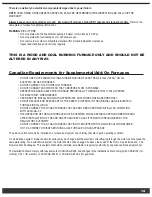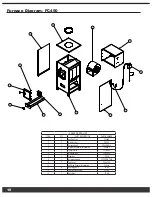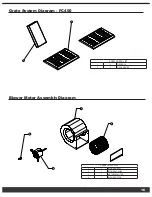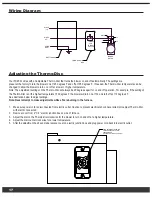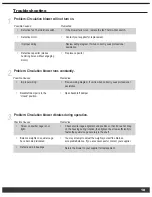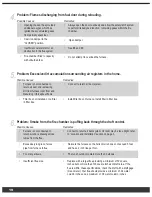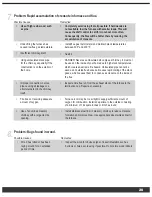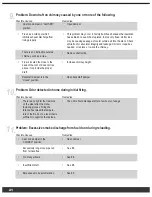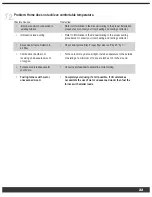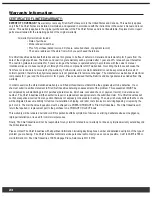
12
the break in period. Adequate ventilation within the home and furnace room or area is recommended during the initial firing and break
in period to accommodate this possibility. Your new Fire Chief Furnace is classified as having airtight construction. This type of design
should enable you to experience an average burn time between 6 and 12 hours per full load of fuel (dry, seasoned hardwood). However,
abnormally cold weather may reduce the burn time somewhat. If your burn cycle is significantly less, for instance, 2 to 4 hours, you are
over-firing your furnace. This type of occurrence is usually symptomatic of heat demands in excess of furnace capacity. Contact an
authorized professional to determine if your Fire Chief Furnace has been improperly sized for your home.
Loading Wood:
When opening the fuel door during operation, wait 10 seconds after releasing the first latch, then open the door the rest of the way. The
dual latch system has been incorporated as a safety feature, designed to eliminate the possibility of gaseous ignition. Laboratory testing
has determined that when incomplete combustion occurs the partially spent fuel sometimes concentrates large amounts of potentially
hazardous gases within the fire chamber. If the door is opened suddenly under these conditions, the oxygen may combine with these
gases and cause ignition referred to as “back flash.” Use EXTREME CAUTION when opening the fuel door.
When reloading the furnace, spread embers evenly over the grate. Place smaller pieces of wood or coal on the hot embers and layer
larger pieces on top of them. Finally, due to the wide variety of temperature ranges during the winter, you may experience periods
when it is not necessary to fully load the fire chamber in order to maintain an overnight burn. Your Fire Chief Furnace will operate
at the highest efficiency by adding fuel in amounts needed to maintain comfortable temperatures in your home.
Starting the First Coal Fire:
Burning coal is much harder than burning wood. There is more care and work in building and maintaining a coal fire than a wood fire.
Anthracite is the best coal to burn, due to its long even burn with higher heat output and clean burn quality but is more difficult to manage
than Bituminous coal.
The size of coal is important. “Nut” coal sizes of 4 inches for Bituminous and 2¾ to 4½ inches for Anthracite coal are recommended.
Never use coal other than the sizes recommended. If the coal is too small it will smother the fire and if it is too large the coal will not burn
well.
When burning Bituminous coal, start the fire with wood (as described above). Always use dry kindling, as this will provide a hotter fire
and add small pieces of wood until you get a good hot ember bed. At this point add a small amount of coal. When the coal is hot enough
to ignite, add small amounts at a time, so as not to smother the fire. Keep in mind that Bituminous coal will require more maintenance as
this type of coal will produce more soot, requiring more frequent cleaning to prevent buildup.
Also make sure that the spin draft is wide open to establish the correct burn pattern. When adding coal to Bituminous fires always add
coal to the center of the bed creating the cone effect. Bituminous coal is more volatile and adding coal to the center of the bed causes
the flames to drive off the volatile gases. Remember that no two installations and chimney set-ups are the same, so be prepared to
experiment until you achieve the desired results. Always allow enough air to the firebox and keep the damper open so that volatile gases
are properly burned. When adding fuel, remember to break up the cone with a poker if it has formed a crust, but be careful to avoid
mixing the coal as this can form clinkers. Excessive movement wastes fuel and exposes the grate to extreme heat, which will cause
warping or burnout. For overnight burn operations, follow the above instructions and adjust the chimney damper.
When burning Anthracite coal, start the fire with wood (as described above). Add layers of coal making sure not to smother the fire, the
third layer should be a little heavier, but should not extend above 2 inches below the top of the brick in the firebox. Before adding
more fuel, be sure to leave a red spot in the center of the bed. This hot spot will help ignite the gases given off the new charge. A deep
charge will give a more even heat and a longer fire. It may take up to a couple hours before the whole bed is fully ignited. When the fire
is established and the home is becoming warm, you may adjust the damper. Once the coal bed has reduced to half its original depth it
is time to add fuel to the furnace. Open the fuel door, using a small rake or hoe pull the coals towards the front of the bed, trying not to
disturb the fire too much. Next, add coal to the back, being careful not to seal off the top. Allow the ash to fall into the ash pan. Keep
the ash pan cleaned out to ensure good airflow. You may want to start this banking process early in the evening before retiring or before
leaving the home so that you may make proper adjustments after the fire is well established.
WARNING: It is unsafe to load any type of coal within 2 inches of the top of the firebrick. Load fuel carefully or damage may result.
*BE SURE TO KEEP WOOD COVERED YEAR ROUND!*

















